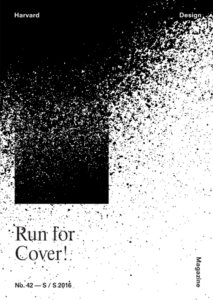Unsettling Unsettlements
The late 1960s and 1970s ushered in a new era in transnational governance. For the first time, the world was coming together to confront not just the threat of war, but new fears spurred by the rapid changes affecting natural and human habitats. In her recent book Outlaw Territories: Environments of Insecurity / Architectures of Counterinsurgency, architectural historian and theorist
Felicity D. Scott describes the moment when interconnections between humankind and the environment came to occupy center stage in international forums, a phenomenon Scott calls “environmentality.” The key institutions in Scott’s narrative—UN-Habitat, the United Nations Environment Programme, the Ford Foundation, and others—are now landmarks in the global political landscape. We have bought into their mandates and become familiar with their structures and modi operandi. So prevailing are these institutions in our world that we have forgotten the climate in which they originated. Scott offers us a powerful reminder that much of this infrastructure was built in response to fear.
Environmentality, she argues, emerged as a product of anxieties over new territorial and environmental insecurities. In the first throes of globalization, people were worried about demographic explosion, resource scarcity, decolonization, and the appearance of what Scott calls human “unsettlements”—the temporary habitats of displaced and “illegal” populations, which thwarted our faith in the stability of the Westphalian state system. The explosion of postindustrial technologies, coupled with a more aggressive brand of capitalism, was already disturbing political and national identities worldwide. A refined understanding of environmental threats was giving birth to ecological consciousness. This period also marked the end of the exaltation surrounding outer-space exploration and signaled a growing unease toward planetary interconnectedness. This amalgam of fears was reshaping the collective imaginary and inspiring new types of political mobilization, both within established systems and against them. Scott describes the latter—the marginal spaces where countermovements and insurrection occurred—as “outlaw territories.”
But fear is only one side of Scott’s story. She locates her discussion precisely at the interface between fear and the intrinsic potential embodied in outlaw territories—spaces that are in fact fertile ground for change. As intellectual frontiers, they have yet to be absorbed into legality and regulations; they are zones of exception, which lend themselves well to entrepreneurial endeavors and scientific discoveries. There is, however, a caveat: if these threshold areas are ripe for innovative appropriation, they can just as well be negatively appropriated. Scott’s position is therefore not entirely optimistic, and it reminds the reader that margins and borders are key sites where power reasserts its strength (by criminalizing the Other) and expands its reach (by filling juridical voids).
Many of the fears that Scott highlights still haunt us today. Indeed, our contemporary societies are consumed by dilemmas around extreme human mobility and dwindling state sovereignty. If anything, protracted conflicts, climate change, recurring environmental disasters, and ever-widening socioeconomic disparities have heightened our collective anguish. More recently, the refugee “crisis” has exposed deep flaws within international regulatory systems, proving their tools to be ineffective, if not resolutely obsolete. In addition, it has fueled the proliferation of unsettlements. Ranging from the detention zones and migrant camps that dot the Mediterranean shores to the permanent urban resettlement solutions in European and Middle Eastern cities, these spaces of ambiguous jurisdiction are still imbued in a rhetoric of illegality and criminality. They continue to be construed as zones of exception and fixed in a temporal and territorial limbo.
Scott’s book offers hope that we, as designers, are not bound to reproducing the status quo, but have the potential to serve discordant voices and rebel aspirations. By lifting the veil of exceptionality under which outlaw territories remain confined, we can reinvest these spaces with the new norms of civility and justice that they deserve. However, Scott’s propositions remain within the theoretical realm, and leave the design disciplines with little guidance as to how to rethink their concrete interventions. The professionals among us remain caught between two narratives: first, a mainstream, positivist view of our roles as technical experts engaged with aid NGOs, the military, UN agencies, and other global actors; and second, in line with Scott, a high-theory, meta-critique, that frames the spatial dimensions of crisis-response interventions in terms hardly transferable to the nitty-gritty, messy reality of our work. And yet, as designers, architects, and planners, we are hard-pressed to “fix” the ever-expanding, ever more complex unsettlements. It has become imperative that we redefine our practice as both critically informed by and attuned to the material and everyday substance of the politics of environmentality.
Marianne F. Potvin is a PhD candidate at Harvard University, where she studies the intersection of humanitarian action and urbanism. Potvin has led field teams in Iraq, Afghanistan, and Darfur for the International Committee of the Red Cross, the International Rescue Committee, and the United Nations Refugee Agency.
